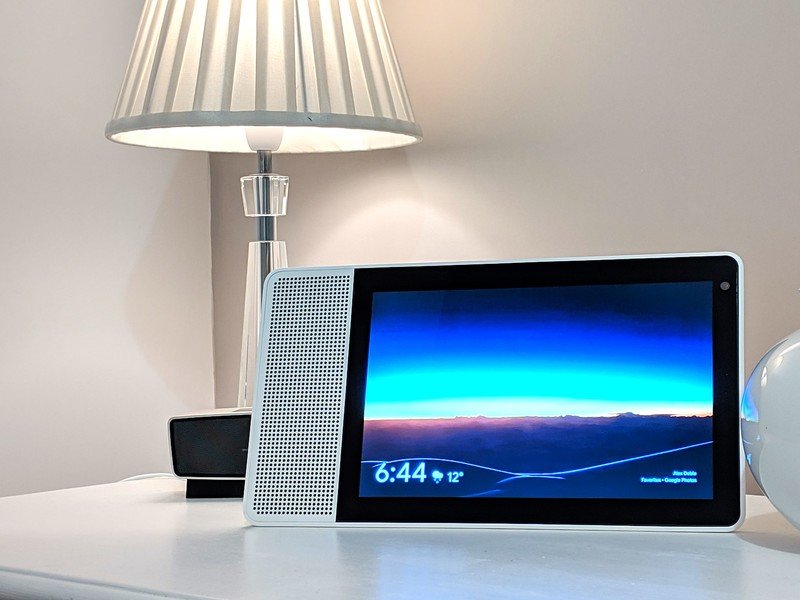Building a smart home: How Google Assistant powers my life

I jump into bed and say the words "Hey Google, goodnight". Then more than 25 smart lights turn off, my thermostat kicks in, the TV sleep timer is set to one hour, the security alarm is activated, and Google asks me for what time to set my alarm. That's my bedtime routine, and I love it.
Last December, I moved to a high-rise building in Brooklyn and set about realizing the dream of a fully connected home. As a rental condo, there are certain things I can't do, but for the most part, I'm living in that dystopian future where you can control most items in your apartment with your voice.
Over the coming weeks, I'll take you on a much deeper tour of my apartment to hopefully give you ideas for your home. I'll also give you some tips on things you can do to make your apartment smart, especially if you are a renter. Kicking off this multi-part series is a look at smart speakers, specifically why I eventually picked Google Assistant over Alexa, and how Assistant and Routines have changed the way I live.

Every home needs a smart display.
If only as a smart home controller, every home needs a smart display, and the Lenovo Smart Display is my favorite Assistant-powered screen. It's essential to my kitchen, and I use it more than I thought as a touch-screen controller for my apartment. Whether it's to control my home, as a second screen for the kitchen, or as a photo frame for the bedroom, there's plenty of reasons you should buy a Lenovo Smart Display!
Assistant vs Alexa – a difficult choice
Why you can trust Android Central

Powering the entire apartment and over 50 connected devices is Google Assistant. Deciding between Alexa and Google Assistant ultimately came down to accessibility, usability, and connectivity. Google Assistant is simply more accessible as I have 30+ devices on hand that has it built-in. It's enabled during the setup of the phone, and while I could add Alexa as an app, it adds another step to an already-tedious process. I do have an Echo Dot in my apartment, but it's the only Alexa device I use.
I also use a lot of Google products and have been burned before by picking Amazon over Google. Two years ago, Google's and Amazon's disputes led to YouTube being pulled from the Echo Show overnight… literally. Back then, the Echo Show was the only smart display on the market, and business disputes led to the crippling of a product I used. With Google limiting the Works With Nest program in favor of more select integrations, the smart home is repeating the mistakes of the smartphone wars and I'd rather not be caught in the middle again.
The Assistant devices

Both Assistant and Alexa do one thing well: they come in just about every shape and form you could wish for. Furthermore, any good product for the home should now support at least one of these two platforms, meaning most things can be easily integrated. If you don't have a Google Assistant device, this list of Assistant smart speakers is a great place to start.

In my small one-bedroom condo, I've got five dedicated Assistant products. In the bedroom is a Google Home, which I've had since Google announced it almost three years ago. The kitchen features the 10-inch Lenovo Smart Display which is the perfect place for it. I've used it for a couple of Duo calls with family abroad, as well as the odd recipe, but mainly I use it for dedicated smart home controls which pop up after you make an Assistant request. The media parts are lost on me as I have a 75-inch TCL TV on a wall less than three feet away, but for most people, it'll be a handy screen to have. My old apartment didn't feature the same open flow I have now, so the Smart Display doubled up as a TV in my kitchen.
Google still has a long way to discover the full potential of Assistant-powered smart displays, but this is where it has the most potential. I love the screen that allows you to control all of the devices connected to Assistant, but it would be even better if you could make that your homescreen.
The Pixel 3 should be at the center of your Assistant-enabled smart home.
Beyond the kitchen, I also have a Google Home Mini tucked away in my bathroom. I love having music in my bathroom, and it's especially useful to have a voice assistant to hand when you want to check traffic while you're getting ready for a meeting.
Arguably my favorite Assistant device is my Pixel 3. It's a great phone, but my Android phone of choice is the P30 Pro. Why I love the Pixel 3 is the Google clock app — I use it to set my alarm for the morning and once I inevitably press snooze, have it change the lights, play music and set the thermostat. Most days, it's the perfect wake up call, and I can't wait for the day where it also opens my blinds.
Some big problems I foresee

I love Google Assistant and it's changed my life, but Google has a lot of work to do to keep it stable. Starting early last year, Google Assistant has slowly become less reliable. It used to be infallible, handling almost every request with ease and less than 1% of errors. Recently, the error rate has been closer to 30-35% and as I add more devices, it will continue to degrade further.
Part of this comes down to the way you name individual items like lights, and part of it is the stability of Google Assistant itself. I work from home, and probably send Google Assistant over 200 requests every day. Assistant is great, but Google needs to work on ensuring it's more stable than it has been, and that responses are faster than the ever-slowing status quo.
How Assistant integrates into my life



The most recent change in my apartment was two days ago: I replaced the dual-gang wall switch in my bathroom with this awesome one that integrates with Assistant and costs less than $40. Why? Far too often I'll forget to turn the bathroom light off when I jump into bed or leave for a trip. My bathroom also uses halogen lighting that's delicate, unreliable and expensive to replace. It's also impossible to buy smart bulbs for these custom fixtures, so replacing the wall switch was the only way to integrate it.
Routines are the backbone of how Assistant integrates into my life. I've set up a total of 17 routines for everyday tasks including when I'm cooking, cleaning, watching a movie, entertaining friends, having dinner, going to bed, leaving home, and much more. Assistant is fantastic as it makes complex routines as simple as uttering a couple of words – it really is like magic seeing all of these things happen just by speaking a few words.
All of this happens when I say "Ok Google, goodnight" and happens faster than I could do it myself.
Take my bedtime routine — it started innocently enough, connecting a few lights. Several months later, the routines now turn off all the lights apart from the strip behind my bedroom TV which it dims to 25 percent, changes the lights to purple and activates a scene that automatically fades it out over an hour. It sets my Nest Guard to Home & Guarding, changes my Nest thermostat to 68°, and ensures the living room TV is turned off. Lastly, it talks to my bedroom OLED to set the sleep timer to 1 hour, changes the volume to 11, and launches Netflix. All of this happens when I say "Ok Google, goodnight" and takes about 60-90 seconds from start to finish, which is much faster than I could do it all manually.
Google Assistant is an essential part of my life.
Routines have become a crucial part of my life, but just as essential is the ability to control every device in my home. Aside from the large appliances and certain things I can't change (like the apartment door and the blinds), Assistant can control everything in my apartment.
Living a connected life

Technology is meant to make our lives easier, and it took me a while to find the true meaning of this. Yes, you need to spend a lot of money to live a truly connected life: I have invested several thousands of dollars on all the connected devices in my apartment. Yes, there are privacy concerns: there are so many Assistant devices in my home that I pretty much assume Google is constantly listening and that I have no privacy. Yes, there is such a thing as too much tech, but ultimately, with routines, technology just fits into my life.
Google Assistant routines are technology magic, enabling a complex series of actions with just a few words.
Do I need all the lights in my apartment to be voice-controlled? No, I could just flip a switch. Do I prefer being able to control everything wherever I am, as well as control each light individually rather than have them controlled by one or two physical switches? Absolutely! When you can customize each light to a specific color or shade of white, your home can become your version of tranquility.
Of course, picking the right devices and ecosystem(s) is a large part of the battle. During the coming weeks, I'll dive deeper into some of the choices I made. LIFX and Philips Hue are the two biggest names in smart lighting, yet they each take a different approach. I've used both for years, and next week I'll walk through each device and how I've managed to integrate both side-by-side in my life.
Stay tuned for that but in the meantime, here's a quick tip to leave you with: when adding a device to Google Assistant, make sure it has a unique name. You should always try and do this from whichever provider you're using (e.g. you'd change the name of your Hue lights in the Hue app rather than Assistant) so the change stays whenever you refresh your device list. As you add more devices, Google Assistant does struggle with device recognition so the more unique the name, the better.
The Google Assistant devices I use

Lenovo Smart Display (From $170 at B&H Photo Video)
Every home needs a smart display.
If only as a smart home controller, every home needs a smart display and the Lenovo Smart Display is my favorite Assistant-powered screen. It's essential to my kitchen, and I use it more than I thought as a touch-screen controller for my apartment. Whether it's to control your home, as a second screen for your kitchen, or as a photo frame for the bedroom, there's plenty of reasons you should buy a Lenovo Smart Display!

Google Home Mini ($25 at B&H Photo Video)
Get started on a budget..
Getting started is surprisingly easy – all you need is a Google Home Mini. I love the Mini as it's cheap yet powerful enough to wake me up in the morning (at 100% volume). It's perfect as a bathroom companion – sing along in the shower by playing your favorite playlist while you let the water run through your hair.

Pixel 3a ($399 at Amazon)
Get your day started, as soon as you hit snooze.
Make snoozing worth it, as you slowly awake ready to start your day. The one key feature currently missing from Google Assistant is the ability to run routines when you hit the snooze button, unless you have a Pixel 3a. Whether it's changing lights, opening blinds, starting the coffee maker or more, it's a powerful way to get your day started.
Get the latest news from Android Central, your trusted companion in the world of Android

Nirave is a veteran tech journalist and creator at House of Tech. He's reviewed over 1,000 phones and other consumer gadgets over the past 20 years. A heart attack at 33 inspired him to consider the Impact of Technology on our physical, mental, and emotional health. Say hi to him on Twitter or Threads
